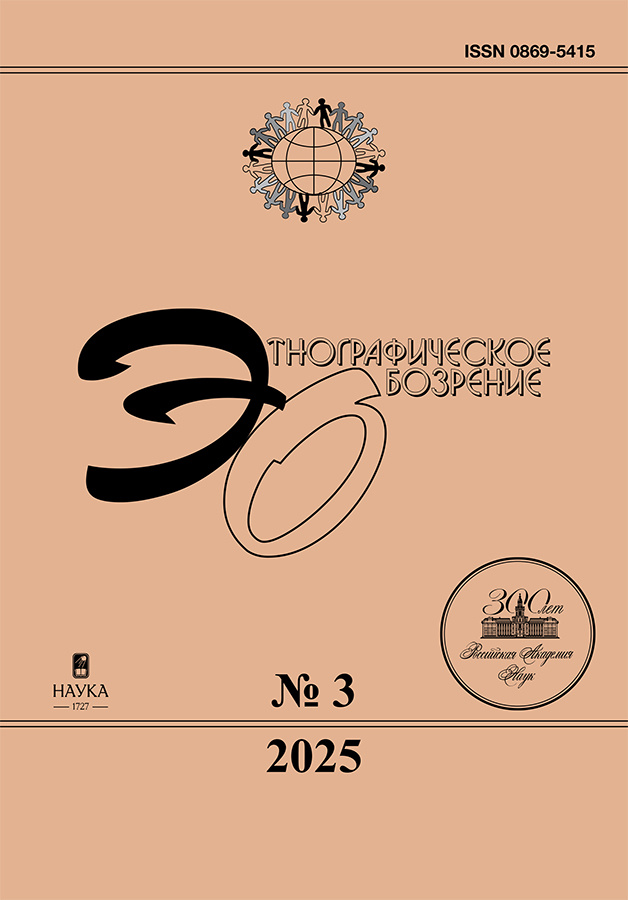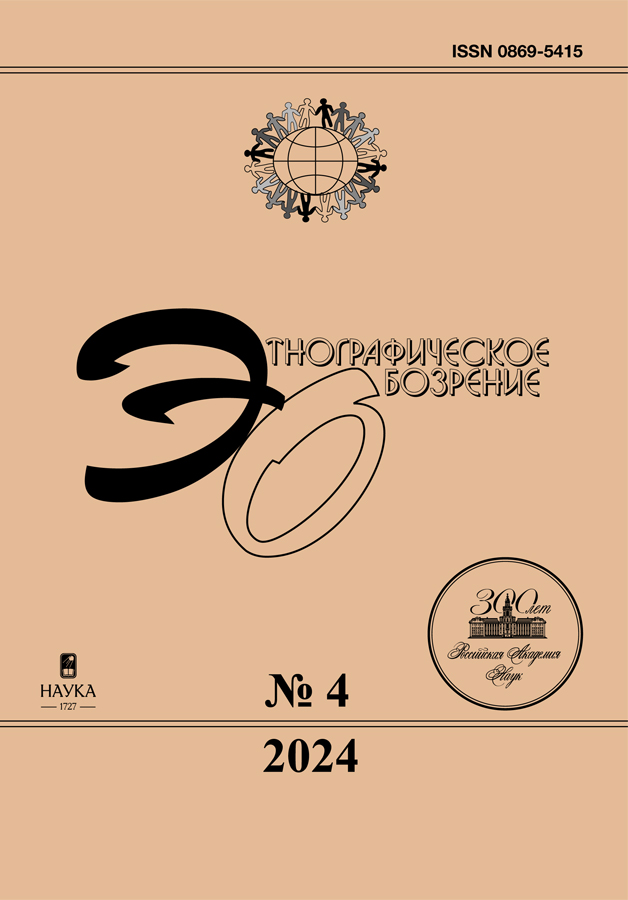Touching the City: Tactility and Affect of Public Art
- Authors: Radchenko D.A.1
-
Affiliations:
- Russian Presidential Academy of National Economy and Public Administration
- Issue: No 4 (2024)
- Pages: 39-55
- Section: Special Theme of the Issue: Anthropology of Affective Atmospheres
- URL: https://cijournal.ru/0869-5415/article/view/672448
- DOI: https://doi.org/10.31857/S0869541524040033
- EDN: https://elibrary.ru/AZAXNU
- ID: 672448
Cite item
Abstract
Touching objects of public art is one of the most frequently recorded and at the same time superficially described practices of interaction with the urban environment. I propose to look at this practice through the lens of the “affective atmospheres” approach, which allows us to problematize tactile contact as a means and result of affective attunement with space. Analyzing the affective-discursive canon, emerging around the interaction with a new art object (the sculpture “Big Clay No. 4” in Moscow), I demonstrate how, on the one hand, the transition from digital to visual and tactile interaction with the materiality of space creates collective affect online; on the other hand, how this affect is transmitted to social media, making the public art object the center of a phygital hybrid space.
Full Text
About the authors
Daria A. Radchenko
Russian Presidential Academy of National Economy and Public Administration
Author for correspondence.
Email: darradchenko@gmail.com
Institute for Social Sciences
Russian Federation, 82 Vernadsky Avenue, Moscow, 119571References
- Antonov, D. 2018. Dva “tela” ikony: obshchenie s obrazom kak apropriatsiia sily [Two “Bodies” of an Icon: Communication with an Icon as Appropriation of Power]. Vestnik RGGU. Seriia: Literaturovedenie. Yazykoznanie. Kul’turologiia 7 (40): 9–34.
- Bareither, C. 2021. Capture the Feeling: Memory Practices in between the Emotional Affordances of Heritage Sites and Digital Media. Memory Studies 14 (3): 578–591.
- Bille, M., and K. Simonsen. 2021. Atmospheric Practices: On Affecting and Being Affected. Space and Culture 24 (2): 295–309.
- Candlin, F. 2017. Rehabilitating Unauthorised Touch or Why Museum Visitors Touch the Exhibits. The Senses and Society 12 (3): 251–266.
- Classen, C., and D. Howes. 2006. The Museum as Sensescape: Western Sensibilities and Indigenous Artifacts. In Sensible Objects: Colonialism, Museums and Material Culture, edited by E. Edwards, C. Gosden, and R. Phillips, 199–222. Oxford (NY): Berg.
- de Souza e Silva, A. 2004. Mobile Networks and Public Spaces: Bringing Multiuser Environments into the Physical Space. Convergence 10 (2): 15–25. https://doi.org/10.1177/135485650401000203
- Griffero, T. 2013. The Atmospheric “Skin” of the City. Ambiances. Environnement sensible, architecture et espace urbain. https://doi.org/10.4000/ambiances.399
- Griffero, T. 2014. Atmospheres and Lived Space. Studia Phaenomenologica 14: 29–51.
- Griffero, T. 2019. Is there Such a Thing as an “Atmospheric Turn”? Instead of an Introduction. Atmosphere and Aesthetics: A Plural Perspective, edited by T. Griffero and M. Tedeschini, 11–62. Cham: Palgrave Macmillan.
- Jackson, P., and J. Everts. 2010. Anxiety as Social Practice. Environment and Planning A: Economy and Space 42 (11): 2791–2806.
- James, M.M., and J.F. Leader. 2023. Do Digital Hugs Work? Re-Embodying Our Social Lives Online with Digital Tact. Frontiers in Psychology 14: 910174.
- Kinnunen, T., and M. Kolehmainen. 2019. Touch and Affect: Analysing the Archive of Touch Biographies. Body & Society 25 (1): 29–56.
- Kormina, J. 2008. Sviataia energetika “namolennogo mesta”: o yazyke pravoslavnyh palomnikov [Saint Enegetics of Prayed Place]. In Natales grate numeras? Sbornik statei k 60-letiiu Georgiia Ahillovicha Levintona [Natales Grate Numeras? Essays in Honour of 60th Anniversary of Georgy Akhillovich Levinton], edited by A.K. Baiburin and A.L. Ospovat, 251–265. St. Petersburg: Izdatel’stvo Evropeiskogo universiteta v Sankt Peterburge.
- Kormina, J., and S. Luehrmann. 2017. The Social Nature of Prayer in a Church of the Unchurched: Russian Orthodox Christianity from Its Edges. Journal of the American Academy of Religion 86 (2): 394–424.
- Kupriyanov, P.S., and M.L. Lurie. 2022. “Vot etot vot duh, kogda on est’, eto vsegda ochen’ zdorovo…”: kak rabotaiut kul’turnye atmosfery i za chto ih liubiat [“This Spirit, when You Feel It, It is Always Very Cool…”: How Cultural Atmospheres Work and Why Do We Like Them]. Shagi/Steps 8 (4): 248–275.
- Low, S. 2024. Prostranstvennoe voploshchenie kul’tury. Etnografiia prostranstva i mesta [Spatializing Culture: The Ethnography of Space and Place]. Moscow: NLO.
- Merleau-Ponty, M. 1968. The Visible and the Invisible: Followed by Working Notes. Evanston: Northwestern University Press.
- Michels, C. 2015. Researching Affective Atmospheres. Geographica Helvetica 70 (4): 255–263.
- Panchenko, A.A. 2012. How to Make a Shrine with Your Own Hands: Local Holy Places and Vernacular Religion in Russia. In Vernacular Religion in Everyday Life: Expressions of Belief, edited by M. Bowman and Ü. Valk, 54–74. New York: Routledge.
- Paterson, M. 2005. Affecting Touch: Towards a Felt Phenomenology of Therapeutic Touch. In Emotional Geographies, edited by J. Davidson, L. Bondi, and M. Smith, 161–176. Aldershot: Ashgate.
- Paterson, M. 2006. Feel the Presence: Technologies of Touch and Distance. Environment and Planning D: Society and Space 24 (5): 691–708.
- Paterson, M., M. Dodge, and S. MacKian. 2012. Introduction: Placing Touch within Social Theory and Empirical Study. In Touching Space, Placing Touch, edited by M. Paterson, M. Dodge, and S. MacKian, 1–28. London: Ashgate Publishing.
- Petrov, N.V. 2014. Pamiatniki v prostranstve Moskvy [Monuments in the Space of Moscow]. Zhivaia starina 2: 44–48.
- Samutina, N., and O. Zaporozhets. 2014. Svoi sredi drugih: antropologiia normy v prostranstve tsaritsynskogo parka [Own between the Others: Anthropology of Norm in the Space of Tsaritsyno Park]. In Tsaritsyno. Attraktsion s istoriei [Tsaritsyno: Attraction with History], edited by N.V. Samutina and B.E. Stepanov, 143–187. Moscow: NLO.
- Scriven, R. 2019. Touching the Sacred: Sensing Spirituality at Irish Holy Wells. Journal of Cultural Geography 36 (3): 271–290. https://doi.org/10.1080/08873631.2019.1632404
- Sivak, E. 2014. “Odna karta, mnogo marshrutov”: navigatsiia v parke Tsaritsyno i rezhimy vospriiatiia prostranstva [“One Map, Many Routes: Natigation in Tsaritsyno Park and Regimes of Space Perception]. In Tsaritsyno. Attraktsion s istoriei [Tsaritsyno: Attraction with History], edited by N.V. Samutina and B.E. Stepanov, 188–214. Moscow: NLO.
- Stewart, K. 2011. Atmospheric Attunements. Environment and Planning D: Society and Space 29 (3): 445–453.
- Townsend, A. 2008. Augmenting Public Space and Authoring Public Art: The Role of Locative Media. ArtNodes E-Journal 8.
- Urry, J. 2016. The Place of Emotions within Place. In Emotional Geographies, edited by J. Davidson, 77–83. Milton Park: Routledge.
- Walkerdine, V., and L. Jimenez. 2012. Gender, Work and Community after De-Industrialisation: A Psychosocial Approach to Affect. New York: Springer.
- Wanner, C. 2020. An Affective Atmosphere of Religiosity: Animated Places, Public Spaces, and the Politics of Attachment in Ukraine and Beyond. Comparative Studies in Society and History 62 (1): 68–105.
- Wetherell, M. 2013. Affect and Discourse – What’s the Problem? From Affect as Excess to Affective/Discursive Practice. Subjectivity 6: 349–368.
- Wetherell, M. 2015. Tears, Bubbles and Disappointment – New Approaches for the Analysis of Affective-Discursive Practices: A Commentary on “Researching the Psychosocial”. Qualitative Research in Psychology 12 (1): 83–90.
- White, G. 2006. Landscapes of Power: National Memorials and the Domestication of Affect. City & Society 18 (1): 50–61.
- Zebracki, M. 2017. A Cybergeography of Public Art Encounter: The Case of Rubber Duck. International Journal of Cultural Studies 20 (5): 526–544.
- Zebracki, M. 2017. Queerying Public Art in Digitally Networked Space. ACME: An International Journal for Critical Geographies 16 (3): 440–474.
Supplementary files











